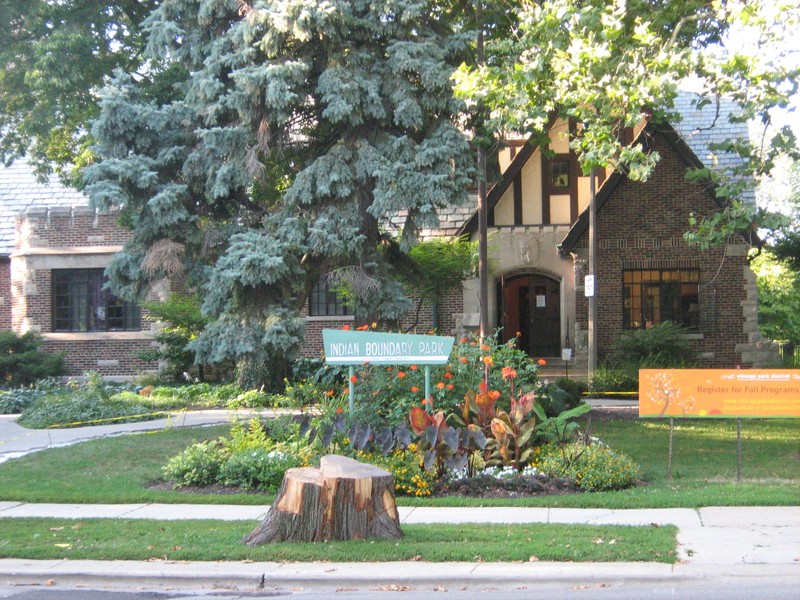Indian Boundary Park & Field House
Introduction
Text-to-speech Audio
Images
By Zol87 from Chicago, Illinois, USA - Indian Boundary Park, CC BY-SA 2.0, https://commons.wikimedia.org/w/index.php?curid=10854765

Backstory and Context
Text-to-speech Audio
The official history of the park, according to the Chicago Park District, is explained:
In 2012, the Indian Boundary Fieldhouse suffered from a fire, but the insurance policy taken by the Park District on the building, listed on the National Register for Historic Places, covered the nearly $1.5 million renovation, which included restoring Native American relief artwork, sculpted from plaster and wood trim, by a restoration specialist.2Indian Boundary Park takes its name from a territorial boundary established by the Treaty of 1816 between the Pottawattomie Indians and the U.S. government. The boundary line, which ran through the land that is now the park, remained in effect only through 1833, when the Pottawattomies were forced entirely from the area in the face of white settlement.
Indian Boundary Park was the second and largest of the four parks created by the Ridge Avenue Park District. The others were Morse (now Matanky), Chippewa, and Pottawattomie. The Ridge Avenue district was the first of 19 neighborhood park commissions established after 1896 to serve areas recently annexed to the city. Chicago's three original park districts had authority only to create parks within the 1869 city limits.
The Ridge Avenue Park District began acquiring land for Indian Boundary Park in 1915. Richard F. Gloede, a designer of North Shore estate landscapes, developed an early plan for the park. In the mid-1920s, the Ridge Avenue Park District opened a small zoo, one of only two zoos in Chicago and initially housing only a lone Black bear. The 1929 Tudor-Revival fieldhouse designed by architect Clarence Hatzfeld features Native American-themed ornament inspired by the park's name. Indian Boundary Park is unusual in that its eastern lawn flows seamlessly into the front yards of neighboring apartment buildings. This park feature was so well-received that in the 1960s the Chicago Park District closed off part of adjacent Estes Avenue as well.
In 2005 Indian Boundary Fieldhouse was designated a Historical Landmark by the City of Chicago and is also listed in the National Register of Historical Places.1
The Native American aspect of this park may exist as one of nostalgia to some, but it truly represents the complicated nature of the Chicago area. For centuries (or more), Native Americans occupied the Chicago-area, using its swampy lands, prairie grasses, and navigable rivers for its own purposes comprised of trapping, hunting, fishing, trading, social activities, and sometimes war. In the 16th century to early 19th century, it became part of what Richard White famously called, the Middle Ground, both representing its geographic location and representative of the need for Europeans (notably French and English) and Native Americans to coexist. Indeed, one of Chicago's original European settlers, John Kinzie, was a trapper and friend of many Natives.3
The United States victory over the the British during the American Revolution, and again in the War of 1812 -- most Native Americans sided with the British, removed any semblance of the Middle Ground. Instead, Natives routinely looked to simply save its land against aggressive westward advancement by the U.S. Whereas the natives could play the French against the British, or vica versa, the U.S. had no real threats, notably after France signed over Louisiana. The treaty of 1816, for which the park draws its name, was one of countless treaties that proved to be temporary pauses in the otherwise broader strategy of the U.S pushing Natives out of the land.4
Many know of President Andrew Jackson's Even such presidents as Thomas Jefferson developed strategies that would result in Native Americans departing the land. It was, in essence, the accepted idea of American's natural progression westward.5
This park, in particular, through the 1816 Treaty of St. Louis, was the demarcation line that provided land and safety for the Ottawa, Ojibwa, and Potawatomi while the U.S. could use a 20-mile swatth of land for trading fur and safe navigation. fur traders to safely pass through or settle in this area. The boundary line of that treaty cut through the park.6
Today, the park serves as a reminder of that struggle between Natives and Anglo-Americans, but also a modern society looking to preserve the culture -- and even accept some wrongs committed, as shown by the admission on the official government website. The park also exists as place to avoid the typical urban ills with a specious park that hosts numerous activities, fests, and otherwise daily leisure.
